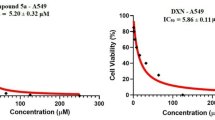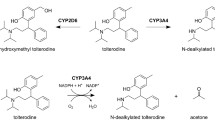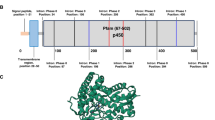Abstract
Summary Tirapazamine (TPZ, SR4233, WIN 59075) is a bioreductive drug that is activated in regions of low oxygen tension to a cytotoxic radical intermediate. This labile metabolite shows high selective toxicity towards hypoxic cells, such as those found in solid tumours. Under aerobic conditions, redox cycling occurs with subsequent generation of superoxide radicals, which are also cytotoxic. NADPH:cytochrome c (P450) reductase (P450R) is a one-electron reducing enzyme that efficiently activates TPZ. Recently a derivative of the A549 non-small cell lung cancer cell line (A549c50) was generated that showed substantially reduced P450R activity compared to its parental line (Elwell et al (1997) Biochem Pharmacol 54: 249–257). Here, it is demonstrated that the A549c50 cells are markedly more resistant to TPZ under both aerobic and hypoxic conditions. In addition, these cells have a dramatically impaired ability to metabolize TPZ to its two-electron reduction product, SR4317, under hypoxic conditions when compared to wild-type cells. P450R activity in the A549c50 cells was reintroduced to similar levels as that seen in the parental A549 cells by transfection of the full-length cDNA for human P450R. These P450R over-expressing cells exhibit restored sensitivity to TPZ under both aerobic and hypoxic conditions, comparable to that found in the original parental A549 cells. Further, the ability of the transfected cells to metabolize TPZ to SR4317 under hypoxic conditions is also shown to be restored. This provides further evidence that P450R can play an important role in the activation, metabolism and toxicity of this lead bioreductive drug. © 2000 Cancer Research Campaign
Similar content being viewed by others
Article PDF
Change history
16 November 2011
This paper was modified 12 months after initial publication to switch to Creative Commons licence terms, as noted at publication
References
Adams GE and Stratford IJ (1994) Bioreductive drugs for cancer therapy: the search for tumor specificity. Int J Radiat Oncol Biol Phys 29: 231–238
Brown JM (1993) SR4233 (Tirapazamine): a new anticancer drug exploiting hypoxia in solid tumours. Br J Cancer 67: 1163–1170
Brown JM and Lemmon MJ (1990) Potentiation by the hypoxic cytotoxin SR4233 of cell killing produced by fractionated irradiation of mouse tumours. Cancer Res 50: 7745–7749
Chaplin DJ, Olive PL and Durrand RE (1987) Intermittent blood flow in a murine tumour: radiobiological effects. Cancer Res 47: 597–601
Dorie MJ and Brown JM (1993) Tumour-specific schedule dependent interaction between tirapazamine (SR 4233) and cisplatin. Cancer Res 53: 4633–4636
Elwell JH, Siim BG, Evans JW and Brown JM (1997) Adaption of human tumour cells to tirapazamine under aerobic conditions. Biochem Pharmacol 54: 249–257
Evans JW, Yudoh K, Delahoussaye YM and Brown JM (1998) Tirapazamine is metabolised to its DNA-damaging radical by intranuclear enzymes. Cancer Res 58: 2098–2101
Forkert PG, Lord JA and Parkinson A (1996) Alterations in expression of CYP1A1 and NADPH-cytochrome P450 reductase during lung tumor development in SWR/J mice. Carcinogenesis 17: 127–134
Forrester LM, Hayes JD, Millis R, Barnes D, Harris AL, Schlager JJ, Powis G and Wolf CR (1990) Expression of glutathione S-transferases and cytochrome P450 in normal and tumor breast tissue. Carcinogenesis 11: 2163–2170
Jain RK (1988) Determinants of tumour blood flow. Cancer Res 48: 2641–2658
Laderoute K, Wardman P and Rauth AM (1988) Molecular mechanisms for the hypoxic-dependent activation of 3-amino-1,2,4-benzotriazene-1,4-dioxide (SR4233). Biochem Pharmacol 37: 1487–1495
Lee D, Trotti A, Spencer S, Rostock R, Fisher C, von Roemeling R, Harvey E and Groves E (1998) A phase II trial of radiotherapy with concurrent tirapazamine, a hypoxic cytotoxin, for advanced head and neck carcinomas. Int J of Radiat Oncol Biol Phys (in press)
Lloyd RV, Duling DR, Rumyantseva GV, Mason RP and Bridson PK (1991) Microsomal reduction of 3-amino-1,2,4-benzotriazine 1,4-dioxide to a free radical. Mol Pharmacol 40: 440–445
Overgaard J (1992) Importance of tumour hypoxia in radiotherapy: a meta-analysis of controlled clinical trials. Radiother Oncol 24: Abs-S64
Patterson AV, Robertson N, Houlbrook S, Stephens MA, Adams GE, Harris AL, Stratford IJ and Carmichael J (1994) The role of DT-diaphorase in determining the sensitivity of human tumour cell to tirapazamine (SR 4233). Int J Radiat Oncol Biol Phys 29: 369
Patterson AV, Barham HM, Chinje EC, Adams GE Harris AL and Stratford IJ (1995) Importance of P450 reductase activity in determining sensitivity of breast tumour cells to the bioreductive drug, tirapazamine (SR 4233). Br J Cancer 72: 1144–1150
Patterson AV, Saunders MP, Chinje EC, Talbot DC, Harris AL and Stratford IJ (1997) Overexpression of human NADPH:cytochrome c (P450) reductase confers enhanced sensitivity to both tirapazamine (SR4233) and RSU1069. Br J Cancer 76: 1338–1347
Patterson AV, Saunders MP, Chinje EC, Patterson LH and Stratford IJ (1998) Enzymology of tirapazamine metabolism: a review. Anti-Cancer Drug Design 13: 541–573
Plumb JA and Workman P (1994) Unusually marked hypoxic sensitization to indoloquinone EO9 and mitomycin C in a human colon-tumour cell line that lacks DT-diaphorase activity. Int J Cancer 56: 134
Riley JR, Hemingway SA, Graham MA and Workman P (1993) Initial characterisation of the major mouse cytochrome P450 enzymes involved in the reductive metabolism of the hypoxic cytotoxin 3-amino-1,2,4-benzotrizene-1,4-di- N -oxide (Tirapazamine, SR 4233, WIN59075). Biochem Pharmacol 45: 1065
Robertson N, Haigh A, Adams GE and Stratford IJ (1994) Factors affecting sensitivity to EO9 in rodent and human tumour cells in vitro: DT-diaphorase activity and hypoxia. Eur J Cancer 30A: 1013–1019
Rodriguez GI, Valdivieso M, Von Hoff DD, Kraut M, Burris HA, Eckardt JR, Lockwood G, Kennedy H and von Roemeling R (1996) A phase I/II trial of the combination of tirapazamine and cisplatin in patients with non-small cell lung cancer (NSCLC) (Meeting abstract). Proc Annu Meet Am Soc Clin Oncol 15: 382
Saunders MP, Patterson AV, Jaffar M, Harris AL and Stratford IJ (1996) Structural requirements for EO9 toxicity and dependence on P450 reductase for activation. Br J Cancer supp 73: XXVI: Abs-P6
Vaupel P (1993) Oxygenation of solid tumours. In: Drug Resistance in Oncology, Teicher BA (ed), pp. 59–85. Marcel Dekker: New York
Workman P and Stratford IJ (1993) The experimental development of bioreductive drugs and their role in cancer therapy. Cancer Metastasis Rev 12: 73–82
Author information
Authors and Affiliations
Rights and permissions
From twelve months after its original publication, this work is licensed under the Creative Commons Attribution-NonCommercial-Share Alike 3.0 Unported License. To view a copy of this license, visit http://creativecommons.org/licenses/by-nc-sa/3.0/
About this article
Cite this article
Saunders, M., Patterson, A., Chinje, E. et al. NADPH:cytochrome c (P450) reductase activates tirapazamine (SR4233) to restore hypoxic and oxic cytotoxicity in an aerobic resistant derivative of the A549 lung cancer cell line. Br J Cancer 82, 651–656 (2000). https://doi.org/10.1054/bjoc.1999.0977
Received:
Revised:
Accepted:
Published:
Issue date:
DOI: https://doi.org/10.1054/bjoc.1999.0977
Keywords
This article is cited by
-
Hypoxia-targeting by tirapazamine (TPZ) induces preferential growth inhibition of nasopharyngeal carcinoma cells with Chk1/2 activation
Investigational New Drugs (2011)
-
The role of bioreductive activation of doxorubicin in cytotoxic activity against leukaemia HL60-sensitive cell line and its multidrug-resistant sublines
British Journal of Cancer (2005)



